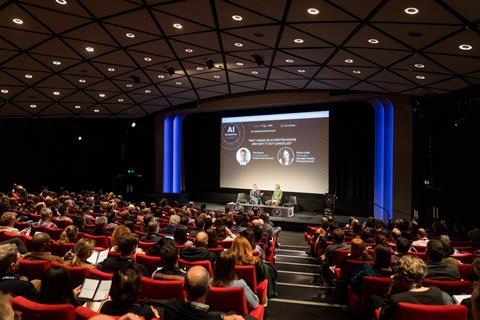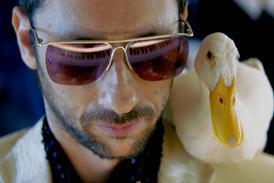
Companies and creatives are waking up to the benefits of Artificial Intelligence (AI) and worries are easing about the negative impacts of the technology on the film and TV industry, according to delegates at this week’s AI Creative Summit, produced by Screen International and its sister titles Broadcast and Broadcast Tech on November 6.
However, there remains acute concern about AI’s impact on jobs and the environment.
The overwhelming message of the day was that the technology is too big and fast-growing to ignore. Analyst Cyrus Mewawalla, head of thematic intelligence at Screen’s parent company GlobalData, described generative AI as “one of the fastest growing technology cycles we’ve ever seen in the history of technology.”
He noted it had taken two months for ChatGPT to reach 100m users, compared to nine months for TikTok, 1.5 years for YouTube and 18 years for Netflix.
“It’s growing very fast. This means you better pay attention, because it’s going to disrupt your industry,” said Mewawalla, who added the AI market opportunity would be worth $1 trillion by 2030.
Easing AI fears
Against this background, many speakers said fears about AI had lessened somewhat. This was echoed by an exclusive poll of the AI Creative Summit attendees, which found that 79% thought that AI’s impact on the creative sector will be positive in the long term. However, the vast majority – 90% - believed that more regulation is required around the use of AI.
James Townley, chief content officer at production and distribution giant Banijay said: “Certainly there is less apprehension about AI than a year ago. We’re really focused on how we can leverage it for a positive for our creatives.”
For many of the speakers, AI is about driving efficiencies and cutting back on boring, repetitive tasks. Grace Boswood, director of technology, Channel 4 said AI will “allow us to do more with less” without ushering a revolution in terms of how it creates content. She said AI is being used to help with tasks such as personalisation of social media content, for example. “We have an infinite scope to personalise our content, but we don’t have an infinite number of people to create clips.”
Damien Viel, chief digital and innovation officer, at Banijay, explained that AI can help it deliver content more effectively to clients. “First steps, we are focusing on logistics and distribution, because this is probably where we have the biggest business savings and the potential to start really [free up money] to contribute more to creativity and to funding new formats.”
Jobs debate
But will it take away creative jobs? Jonny McCausland, development lead at Hat Trick Lab - a development team at Hat Trick Productions with a focus on cross-medium storytelling - said: “I can’t see a world where Hat Trick or any other production company starts replacing writers…we got into this [business] because we love working with writers. That’s the whole fun of making art. I think everything that happens will be additive.”
Added Banijay’s Townley: “From a creative process [point of view], working with AI is absolutely not about potentially losing jobs. It is about how we support our creatives with AI, empowering them, supercharging our pipelines.”
However, many speakers said that the automation of basic tasks by AI would likely lead to fewer entry level jobs into the industry, citing the logging of rushes as one example. But new jobs could be created, such as AI prompters for generating content.
Paul Trillo, one of the few filmmakers granted access to Open AI’s text to video generator Sora, said it is “unsettling” how good Sora is at certain tasks, and that sectors such as VFX would be definitely disrupted.
“Sora is very good at doing chimpanzees. Currently, CG chimpanzees still kind of look like CG chimpanzees, even though the technology has gotten really good. But the chimps that I’ve generated with Sora are undeniably good,” said Trillo, who earlier this year released a music video for the band Washed Out that was generated through Sora.
“VFX artists and VFX companies that are adopting these things and learning how to integrate it with their pipeline, they may be future proofing themselves. But if you are just going to bury your head in the sand and act like this is going to go away, you might find yourself a bit underwater in a couple years.”
Among other concerns was AI’s impact on the environment. Kathryn Webb, the CEO of AI specialist Amici, cited recent research which showed that generating an image using a powerful AI model takes as much energy as fully charging your smartphone.
Governance and guardrails around AI were also a big talking point. “If you’re an independent producer, just a one-man band, or if you’re a massive company like Disney, you need your own AI governance framework,” said GlobalData’s Mewawalla. ”You can’t leave it to the tech vendors.”
Development phase
Many are using the technology in the development phases, employing apps such as ChatGPT, Claude and Midjourney. (In the AI Creative Summit poll 24% of attendees said they used AI for development).
Banijay’s Townley said that AI has helped to dramatically improve development material. “It’s a level playing field for decks and sizzles. The quality has dramatically improved, and so has the speed with which we can put those materials together.”
It’s likely that adoption of the tech will grow quickly. Amici’s Webb said AI technology is advancing at a “logarithmic rate” and that “something produced six months ago can sometimes feel like it’s so old.” She predicted the industry would see more partnerships such as the one recently announced by Lionsgate and Runway, which will create and train a new AI model customized to the studio’s portfolio of film and television content.
Others said that AI could help democratise and diversify the film and TV industry. Channel 4’s Boswood explained that the broadcaster is working with Aardman and immersive experience specialist Charisma.ai and academics on a pilot to explore how AI can lower the barriers of entry for diverse voices. This is early-stage research around how AI can help with storyboarding, scriptwriting and getting content to screen.
“AI is a force that challenges power,” added Hat Trick Lab’s McCausland. “It gives individuals more power to be more creative and to achieve more creatively where it has previously been very expensive [to do so]. It sort of opens the gate a little bit.
“My prediction is that in 12 months’ time, the industry will have realised that a little bit more - and there will be freelancers - whether it’s writers or producers on a very small indie scale - who are doing amazing things with these tools.”






![The Brightest SunScreen[Courtesy HKIFF]](https://d1nslcd7m2225b.cloudfront.net/Pictures/274x183/3/5/0/1448350_thebrightestsunscreencourtesyhkiff_312678.jpg)


















No comments yet